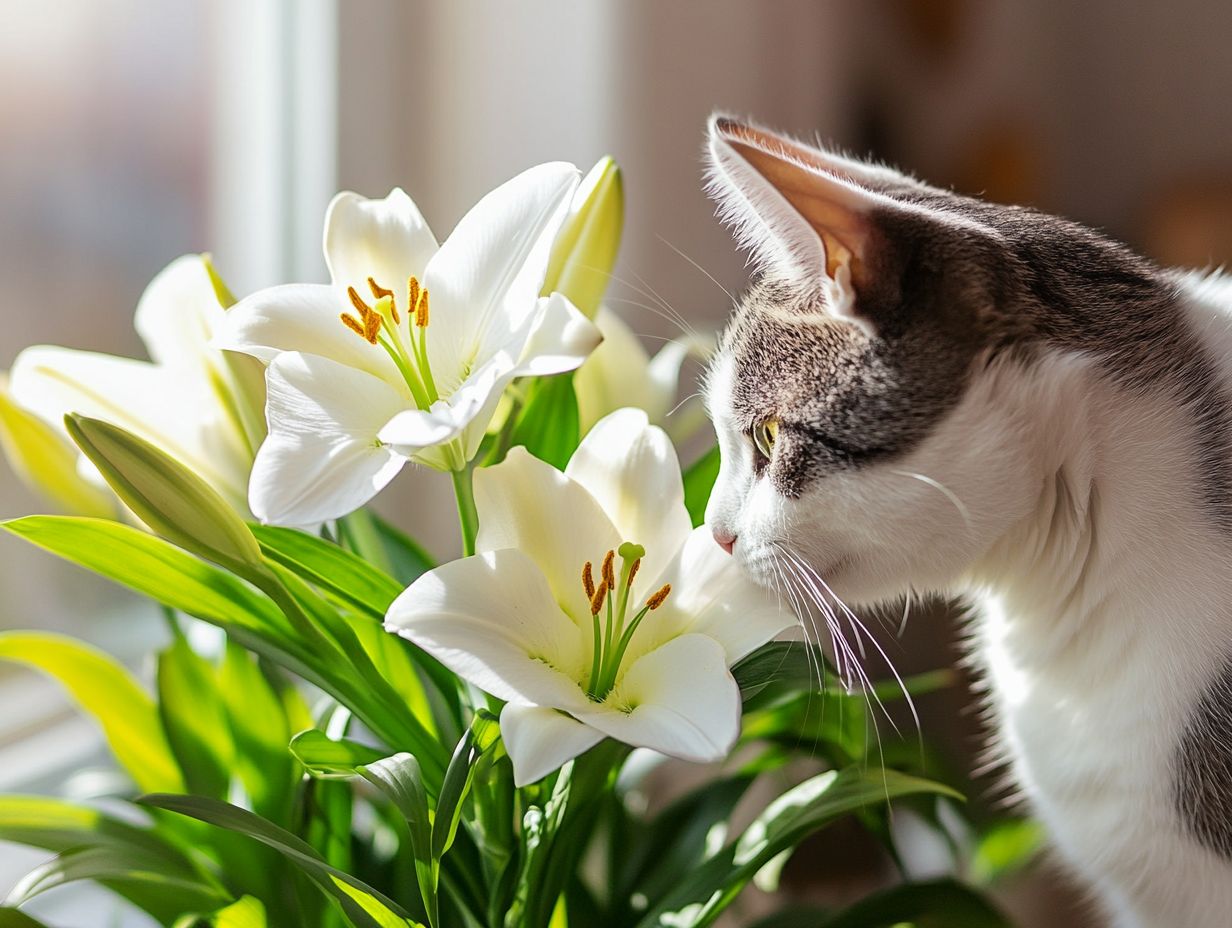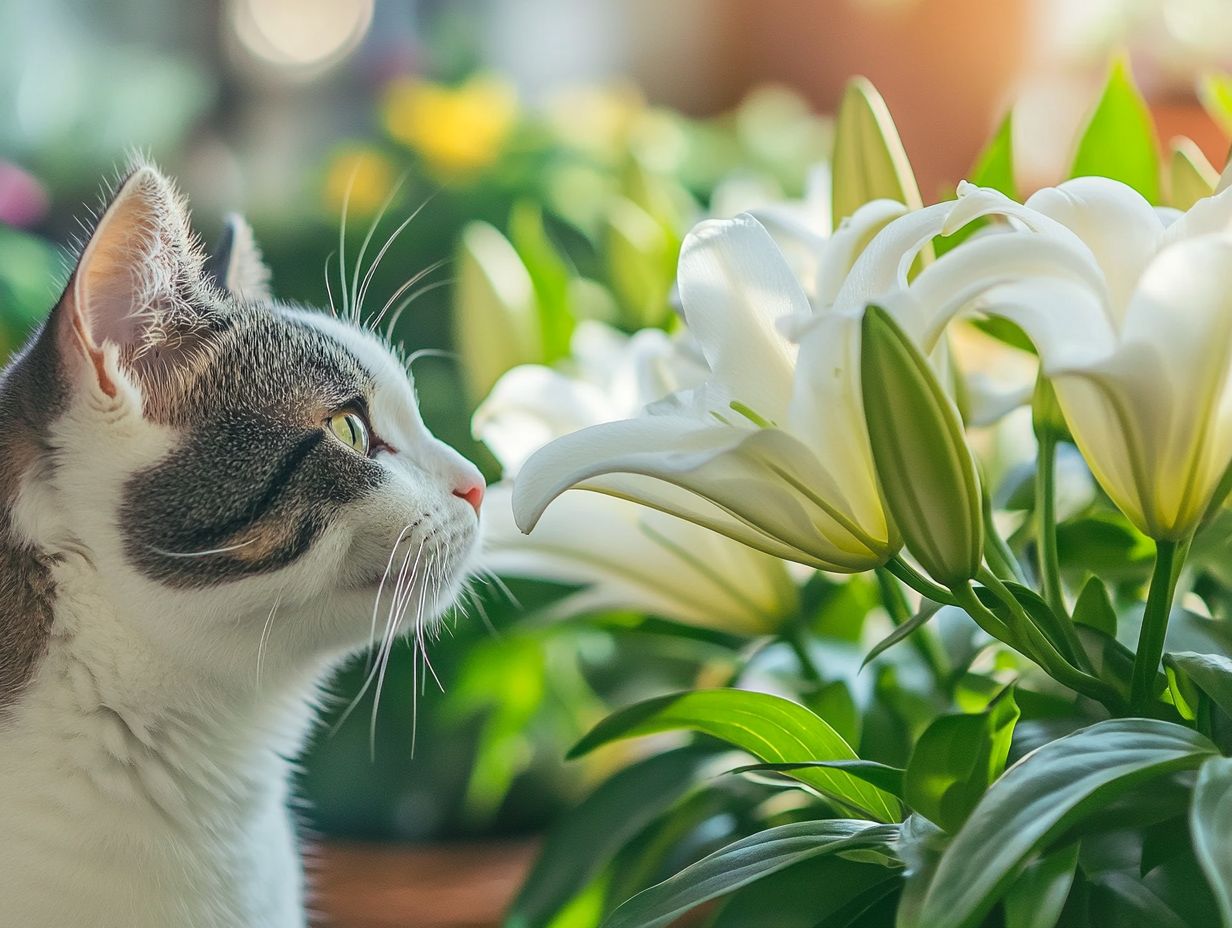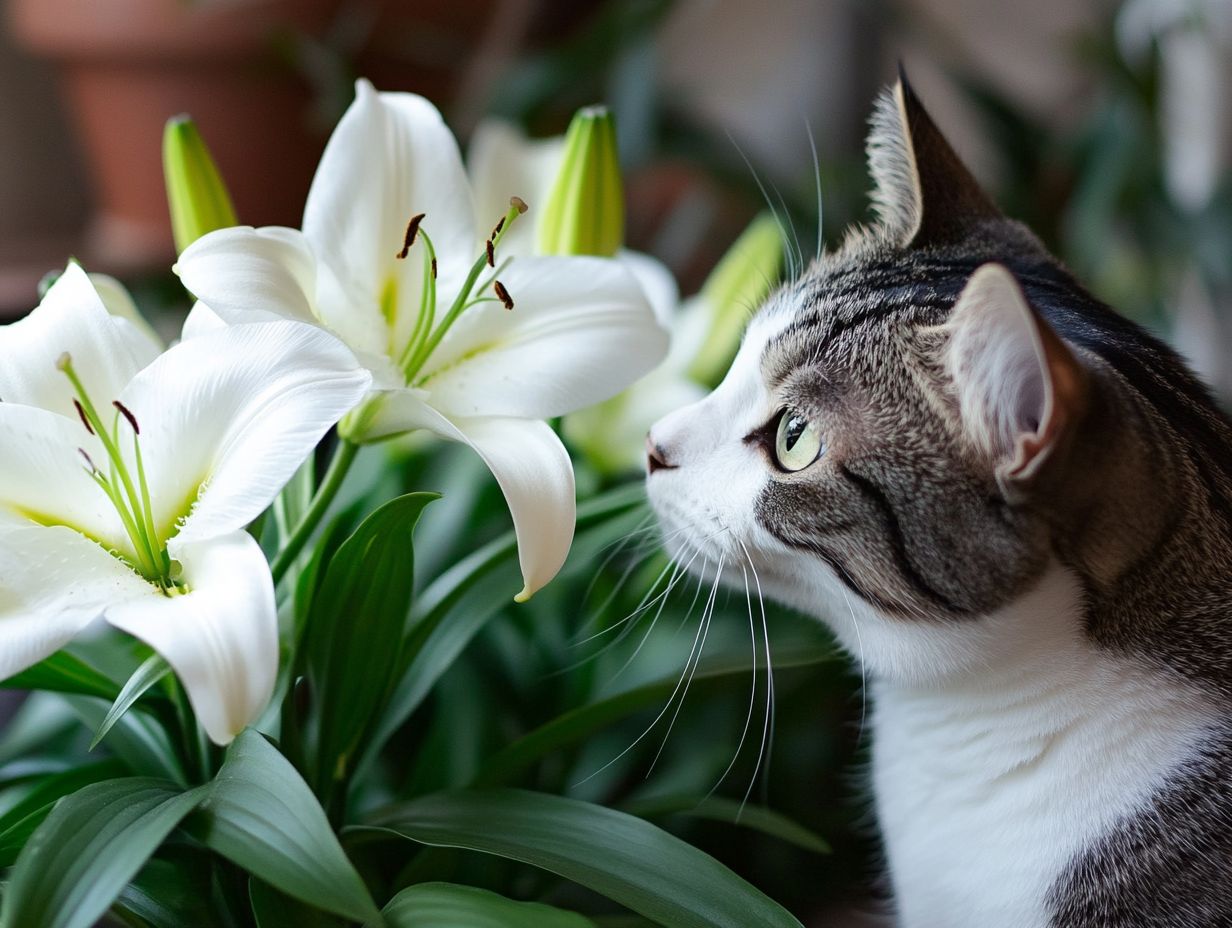Easter lilies, along with other types like tiger lilies, rubrum lilies, and day lilies, are beautiful symbols of the holiday, but they pose a hidden danger for our feline friends. According to the ASPCA Animal Poison Control, Easter lilies are classified as highly toxic to cats.
While these stunning blooms brighten up our homes, their lily toxicity can lead to severe health issues for cats, including potential kidney failure. Veterinary research indicates that even small amounts of these flowers can be dangerous.
This article explores what Easter lilies are, why they are loved during the season, and the serious risks they present to cats, including symptoms such as vomiting and lethargy.
It also discusses the signs of toxicity, early signs of plant ingestion, what to do in an emergency, and safer decoration alternatives, ensuring cat owners are well-informed.
Protect your furry companions this Easter by staying informed about veterinarian advice and safe flowers!
Key Takeaways:

- Easter lilies are highly toxic to cats and can cause kidney failure if ingested. It is important for cat owners to be aware of this danger and take precautions to keep their pets safe during the holiday season.
- Symptoms of lily toxicity in cats can appear quickly and may include vomiting, lethargy, and loss of appetite. If your cat has ingested an Easter lily, it is important to seek immediate veterinary care to prevent kidney damage.
- To prevent lily toxicity in cats, it is crucial to keep Easter lilies out of reach of pets and opt for non-toxic alternatives for decorations. In case of ingestion, inducing vomiting and seeking medical treatment can greatly increase the chances of a positive outcome for your cat.
What Are Easter Lilies?
Easter lilies are exquisite flowers that are closely associated with the Easter holiday. Native to Japan, they gained popularity in the United States during World War I when Louis Houghton introduced them to American gardens in Oregon and California. Their popularity has only increased over the years.
With their striking white blossoms, these flowers are frequently used in floral arrangements to celebrate Easter events. They symbolize purity and renewal.
Why Are Easter Lilies Popular During the Holiday?
Easter lilies are a popular decoration for the Easter holiday due to their beauty and profound symbolism of purity, renewal, and the resurrection of Christ. This makes them cherished in both churches and homes.
What Are the Dangers of Easter Lilies for Cats?
Easter lilies are stunning plants, but they pose a significant danger to cats due to their high toxicity. Ingestion of these flowers can lead to serious health issues, including kidney failure.
Therefore, it is essential for cat owners to be aware of the risks associated with these plants. Common misconceptions about Easter lilies include the belief that only certain parts are toxic; however, all parts of the plant are harmful.
What Are the Toxic Components of Easter Lilies?
Easter lilies contain toxic components such as glycosides that pose a significant risk to cats, primarily causing acute kidney failure and potentially leading to death if ingested. This underscores the serious dangers of lily toxicity for pet safety.
Symptoms of this toxicity may include:
- Mild: Vomiting, mild lethargy
- Moderate: Increased thirst, decreased appetite
- Severe: Rapid kidney failure, potentially fatal symptoms
The risk of irreversible kidney damage highlights the importance of pet owners being aware of the dangers associated with certain plants, serving as a reminder that some beautiful species can be extremely hazardous to pets.
Step-by-Step First Aid for Suspected Lily Ingestion
- Immediately remove any remaining parts of the lily from your pet’s vicinity.
- Contact your veterinarian or an emergency animal poison control hotline (e.g., ASPCA Animal Poison Control) right away.
- If advised, induce vomiting using a safe method, but only if directed by a professional.
- Take your cat to the veterinarian for further evaluation and treatment.
How Much of the Plant Is Toxic to Cats?

All parts of the Easter lily plant are toxic to cats, and even small amounts can lead to severe illness. Therefore, cat owners must take precautions to prevent their pets from ingesting these plants at home.
The roots, stems, leaves, and blooms of this beautiful plant all contain toxins that are particularly hazardous to cats. If a cat consumes even a few petals or drinks water from a vase containing these flowers, it may experience symptoms such as vomiting, lethargy, and loss of appetite.
Keeping Your Cat Safe from Easter Lilies
To minimize risks, consider the following tips:
- Keep Easter lilies out of reach or avoid having them in your home altogether.
- Opt for non-toxic plant alternatives for holiday decorations.
- Educate family members about the dangers of toxic plants to pets.
- Regularly check your home for any potential hazards, especially during the Easter season.
Always consult a veterinarian for specific advice regarding your pets, especially if you have kittens or senior cats, as they may be more vulnerable to toxicity.
For further information about other toxic plants, please visit our related articles.
Disclaimer: This article is for informational purposes only and is not a substitute for professional veterinary advice. Always consult your veterinarian for concerns regarding pet health.
Emergency Contact: For immediate assistance, contact the ASPCA Animal Poison Control at (888) 426-4435.
In more severe cases, there is a risk of acute kidney failure due to lily toxicity, which can be fatal without prompt treatment. Consequently, it is essential for cat owners to not only remove Easter lilies from their homes but also to educate themselves about other plants that pose similar risks. For further information on toxicity levels associated with Easter lilies, see the ASPCA’s Animal Poison Control.
What Are the Symptoms of Lily Toxicity in Cats?
Toxicity Level: Severe
Symptoms of lily toxicity in cats can manifest within hours of ingestion and are categorized as follows:
- Mild Symptoms: Decreased appetite and mild vomiting.
- Moderate Symptoms: Severe vomiting, lethargy, and increased thirst.
- Severe Symptoms: Symptoms indicating a potential health crisis necessitating immediate veterinary care, such as acute kidney failure.
What Parts of the Easter Lily Are Toxic?
All parts of the Easter lily, especially the flowers and leaves, are toxic to cats due to unknown alkaloids present in the plant.
How Soon Do Symptoms Appear After Ingestion?
Symptoms of lily toxicity in cats can appear as soon as six hours after ingestion. Early signs, such as vomiting and lethargy, make it crucial for cat owners to closely monitor their pets if they suspect they have consumed any part of the plant. Prompt recognition of these symptoms greatly influences the outcome. One of the key factors in the progression of symptoms is the speed at which the cat receives treatment, highlighting the importance of pet owners understanding the timing and development of these symptoms.
In some cases, additional symptoms such as loss of appetite, increased thirst, and changes in urine may emerge within a day. The sooner a pet owner notices these signs and takes their cat to a veterinarian, the greater the chance of preventing lasting damage, including acute kidney failure.
What Are the Signs of Kidney Failure in Cats?
Signs of kidney failure in cats include increased thirst, frequent urination, decreased appetite, and lethargy. Being aware of these symptoms can lead to earlier veterinary treatment, potentially preventing irreversible damage.
Other signs to watch for include weight loss, vomiting, and changes in coat texture or quality, which can help pet owners recognize the underlying struggles their feline friend may be facing. Cats are known for hiding their pain, so any minor behavioral change should be taken seriously.
Seeking veterinary care at the first sign of these symptoms can facilitate early diagnosis of kidney issues. Additionally, regular check-ups and health monitoring are crucial for managing a cat’s health, allowing for timely intervention and treatment aimed at maintaining kidney function and enhancing overall quality of life.
What Should You Do If Your Cat Ingests Easter Lilies?
If you suspect that your cat has ingested Easter lilies, it is crucial to seek immediate medical care from a veterinarian. Early intervention can make a significant difference in preventing severe health complications, including kidney failure, and can greatly enhance the chances of recovery.
First Aid and Treatment
- Remove the plant.
- Call your veterinarian.
- Monitor your cat’s symptoms.
For more information, check out the ASPCA’s article on Easter Lilies.
How Can You Induce Vomiting in Cats?

Inducing vomiting in cats should only be done under the guidance of a veterinarian, as improper methods can lead to further complications. If a veterinarian provides instructions, activated charcoal may be used to help prevent the absorption of toxins.
It is crucial to carefully assess the situation before taking any action, as certain substances may require specific treatments, and inducing vomiting might not always be advisable. If a cat consumes a potential poison, the owner should promptly contact a veterinarian for guidance.
In cases where ingestion was recent, inducing vomiting within 1-2 hours may be effective; however, using hydrogen peroxide should only be done if directed by a professional.
For more severe cases or if the cat exhibits symptoms such as lethargy, vomiting, or diarrhea, immediate veterinary assistance is essential to ensure appropriate care and treatment.
What Are the Treatment Options for Lily Toxicity?
Treatment options for lily toxicity in cats typically involve administering IV fluids to support kidney function, along with additional treatments aimed at mitigating the effects of the toxin. Immediate veterinary intervention is crucial.
Veterinarians often recommend hospitalization for close monitoring, as the effects of lily poisoning can deteriorate rapidly. Emergency clinics may provide activated charcoal to prevent further absorption of toxins.
Prevention Tips
- Keep Easter lilies and other toxic plants out of reach.
- Consider safe alternatives like catnip or spider plants.
Note that even non-toxic plants can occasionally cause mild gastrointestinal upset, so caution is advised.
Special considerations should be given to vulnerable groups such as kittens or senior cats, as they may have heightened sensitivities to toxic plants. Seasonal risks associated with holiday plants should also be taken into account.
Please remember to consult your veterinarian for personalized advice, as the information provided here is not a substitute for professional veterinary care.
For emergency situations, contact the ASPCA Animal Poison Control at (888) 426-4435.
This article will be regularly updated with new research findings. Last reviewed: [insert date].
Disclaimer: This content is for informational purposes only and should not replace professional veterinary advice.
For more on pet safety and toxic plants, please refer to our related articles.
Easter lilies are highly toxic to cats. All parts of the plant, including the leaves, petals, and pollen, are considered toxic. Immediate action is crucial if ingestion is suspected. For detailed information, refer to resources like the ASPCA Animal Poison Control and veterinary journals.
Depending on how quickly the cat is brought in after ingesting the plant, blood tests and urinalysis may be performed to assess the extent of kidney damage. Early treatment and aggressive intervention generally lead to a better prognosis for feline patients suffering from lily toxicity.
Therefore, cat owners should prioritize locating an emergency veterinary clinic that can provide the necessary care.
How Can You Prevent Lily Toxicity in Cats?
Preventing lily toxicity in cats is the responsibility of cat owners. This involves removing Easter lilies and other toxic plants from the home and choosing safe flower alternatives.
What Are Some Safe Alternatives for Easter Decorations?
The best flowers for Easter that are safe for cats include daisies, roses, and orchids, allowing for a festive celebration without harm to your feline friends. These flowers are safe because they do not contain toxic compounds that can adversely affect cats. They enhance the holiday atmosphere while ensuring a safe environment for your pets, highlighting the importance of caution with plants.
Daisies are commonly used during this holiday; their hardy nature and bright petals add a cheerful touch. Roses, known for their classic beauty, bring a sweet fragrance that enriches any celebration. Lastly, orchids are exotic and stunning blooming plants that add a touch of elegance to any setting.
Using these flowers for Easter creates a delightful and safe ambiance for both humans and cats, promoting cat health.
What Should You Do If You Suspect Your Cat Has Ingested a Toxic Plant?
If you suspect that your cat has ingested a toxic plant, such as Easter lilies, it is crucial to take it to the vet immediately, as the prognosis can be significantly influenced by the speed of treatment and the progression of the disease.
The first step is to recognize the signs of toxicity, which may include:
- Mild symptoms: vomiting
- Moderate symptoms: lethargy, loss of appetite
- Severe symptoms: kidney failure
Next, contact your veterinarian. If you know the specific plant your cat has ingested, informing the vet’s office can help them assess the situation more quickly, possibly involving a vet technician.
In the meantime, remove any remaining plant material from your cat’s environment to prevent further ingestion. It is essential to remember that many toxic reactions can escalate rapidly, leading to renal failure. Irreversible damage may occur if prompt treatment is not sought. Prioritizing emergency care, including IV fluids and other emergency treatments, is vital to reducing these risks.
Step-by-Step First Aid Guide:
- Remove any remaining plant material from your cat’s environment.
- Contact your veterinarian immediately.
- Provide detailed information about the suspected plant.
- Monitor your cat for any symptoms of toxicity.
- Follow your veterinarian’s instructions closely.
Frequently Asked Questions

Can Easter Lilies be fatal to cats?
Yes, Easter Lilies are highly toxic to cats and can be fatal if ingested.
What are the symptoms of Easter Lily poisoning in cats?
The symptoms of Easter Lily poisoning in cats include:
- Mild: vomiting
- Moderate: lethargy, loss of appetite
- Severe: kidney failure
How much of an Easter Lily does a cat need to ingest to be poisoned?
Even a small amount of any part of the Easter Lily plant, including the leaves, petals, or pollen, can be toxic to cats.
What should I do if my cat ingests an Easter Lily and requires urgent medical attention?
If you suspect your cat has ingested any part of an Easter Lily, take them to a veterinarian immediately. Time is critical in treating Easter Lily poisoning in cats.
Are all types of lilies toxic to cats?
No, not all types of lilies are toxic to cats. For instance, calla lilies and daylilies are safe, while tiger lilies and Asiatic lilies should be avoided. It’s best to avoid all types of lilies in a household with cats to be safe.
What can I do to keep my cat safe from Easter Lily poisoning, according to the Food and Drug Administration and APCC guidelines?
If you have cats, do not bring Easter Lilies into your home, as advised by veterinarians. If you receive them as a gift, keep them in a place where your cat cannot access them. Dispose of any fallen petals or leaves immediately.
Risks for Specific Cat Groups: Kittens and senior cats may be more susceptible to the effects of toxic plants, making it even more important to keep them away from Easter lilies.
Emergency Contact Information: For immediate assistance, contact the ASPCA Animal Poison Control at (888) 426-4435 or reach out to your local veterinary services.
Disclaimer: Always consult your veterinarian for personalized advice and care regarding your pets’ health.